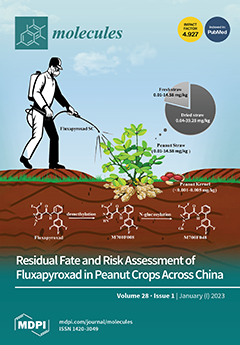The
Clematis tangutica (Maxim.) Korsh. is a wild flowering plant that is most widely distributed on the Qinghai–Tibet Plateau, with beautiful, brightly colored flowers and good ornamental properties and adaptability. In diverse natural environments, the blossom color of
C. tangutica (Maxim.) Korsh. varies greatly, although it is unclear what causes this diversity. It was examined using UPLC-MS/MS and transcriptome sequencing for the investigation of various compounds, differentially expressed genes (DEGs), and flavonoid biosynthesis-related pathways in two flowers in two ecological settings. The results showed that a total of 992 metabolites were detected, of which 425 were differential metabolites, mainly flavonoid metabolites associated with its floral color. The most abundant flavonoids, flavonols and anthocyanin metabolites in the G type were cynaroside, isoquercitrin and peonidin-3-
O-glucoside, respectively. Flavonoids that differed in multiplicity in G type and N type were rhoifolin, naringin, delphinidin-3-
O-rutinoside, chrysoeriol and catechin. Rhoifolin and chrysoeriol, produced in flavone and flavonol biosynthesis, two flavonoid compounds of
C. tangutica (Maxim.) Korsh. with the largest difference in floral composition in two ecological environments. In two ecological environments of flower color components, combined transcriptome and metabolome analyses revealed that
BZ1-1 and
FG3-1 are key genes for delphinidin-3-
O-rutinoside in anthocyanin biosynthesis, and
HCT-5 and
FG3-3 are key genes for rhoifolin and naringin in flavonoid biosynthesis and flavone and flavonol. Key genes for chlorogenic acid in flavonoid biosynthesis include
HCT-6,
CHS-1 and
IF7MAT-1. In summary, differences in flavonoids and their content are the main factors responsible for the differences in the floral color composition of
C. tangutica (Maxim.) Korsh. in the two ecological environments, and are associated with differential expression of genes related to flavonoid synthesis.
Full article






